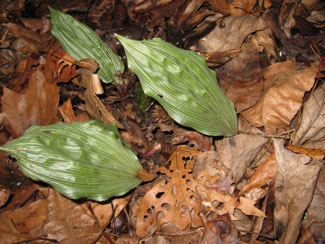Resource Library
Plant of the Week: Orchid, Putty Root
Putty Root Orchid
Latin: Aplectrum hyemale
Orchid, Putty Root -- The Putty Root orchid is a native woodland species that produces a single leaf in the fall that dies away in March before the plant blooms in May. (Image courtesy Gerald Klingaman)
While on a recent walk in Newton County, I spotted a native woodland orchid I’d seen several times before, the putty root or Adam and Eve orchid (Aplectrum hyemale).
The putty root orchid is monotypic, meaning there is only one species in the genus. It ranges throughout the eastern deciduous woodland forest from New England and adjacent areas in Canada to and south and west to east Texas and Oklahoma. In Arkansas it is most commonly reported in the Ozarks but is probably scattered in the deep moist valleys of the Ouachitas too.
Putty root orchid and a similar species, the cranefly orchid (Tipularia discolor), are unique among our native terrestrial orchids in that they display the growth cycle found in fall flowering bulbs such as surprise lilies and spider lilies (Lycoris sp.). In September these orchids send up a single leaf from a spherical bulb-like structure called a pseudobulb. In both species the leaf persists over winter and then, come spring when the tree leaves reappear, that leaf dies away. The cranefly orchid is more common in the Ouachitas but I’ve found it up here in Madison and Newton counties.
In both of these species the leaves are more obvious and attractive than the flowers that appear during tick season, so often go unnoticed in the deep woods where they grow. Putty root has an elliptical 6 inch long, 3 inch wide oval leaf that is a bit crumpled down its length but the veins are beautifully highlighted in white. Cranefly orchid is about half as large but the upper leaf surface is often marked with blotches of purple. Turn the leaf over and it is a solid burgundy color.
Putty root orchid flowers in May soon after the single leaf dies away. Scapes are about the size of a pencil and 12 to 14 inches tall with inch wide yellowish to greenish flowers in the form of a typical orchid equally spaced up the stem. The lip of the flower is white with a purple margin.
Cranefly orchid flowers in late July and early August and is easy to overlook because the stems are slender (about the size as a piece of pencil lead) and the flowers are tan colored, about the color of leaf litter. Flowers are about one-third-inch wide with a single, slender nectary spur extending behind the blossom.
The name putty root comes from a sticky substance produced by smashing the pseudobulb was said to have been used to mend pottery. “Adam and Eve” comes from the underground expansion of the plant when the pseudobulb bearing the leaf (Adam) expands and produces a slightly smaller pseudobulb that is leafless (Eve). The name for cranefly and wounded cranefly orchid comes from the fact the blossoms are about the same size and shape as a cranefly. Because the flowers have either a right or left twist to them, some apply the “wounded” designation.
Neither of these native orchids should be considered garden plants. They are products of the native woodlands and that is where they should stay. Look for them in the winter along moist woodland streams, north facing hills and other areas where rich, highly organic soil conditions are likely to persist. Identify them in the winter and then come back in the spring or summer to see the blooms.
By: Gerald Klingaman, retired
Retired Extension Horticulturist - Ornamentals
Extension News - December 20, 2013
